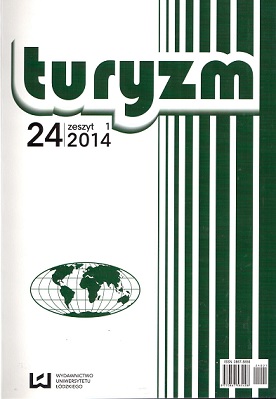Tourism space: an attempt at a fresh look
DOI:
https://doi.org/10.2478/tour-2014-0002Keywords:
tourism space, tourism, poly-functionality, multiple motivation, multi-relativityAbstract
In this article, the author is trying to answer the fundamental question: what is present-day tourism space like at a time of highly increasing flows of people or even a shift from the space of a ‘place’ to the space of a ‘flow’? The article puts special stress on how to define the current unique multi-functional space. The author attempts to define tourism space as a new entity, founded on poly-functionality (i.e. different functions and use of the same space both at the same time and in different seasons), multi-scale (overlapping of tourism spaces depending on the scale concerned), multi-layer, as well as the multi-motivation of its creators and users, or even multi-relativity.
Downloads
References
CACCOMO J.L., SOLONANDRASANA B., 2001, L’innovation dans l’industrie touristique. Enjeux et stratégies, L’Harmattan, Paris.
Google Scholar
CASTELLS M., 1996, The rise of the network society – the information age, Blackwell, Oxford.
Google Scholar
CAZELAIS N., NADEAU R., BEAUDET G. (eds), 2000, L’espace touristique, Presses de l’Université du Québec, Sainte-Foy.
Google Scholar
CHOMBART DE LAUWE P.H., 1952, Paris et l’agglomération parisienne, PUF, 2, Paris.
Google Scholar
COHEN E., 1995, Contemporary tourism – trends and challenges, [in:] R. Butler, D. Pearce (eds), Change in Tourism. People, Places, Routledge, Processes, London–New York.
Google Scholar
FOUCAULT M., 2005, Inne przestrzenie, Wyd. Naukowe PWN, Warszawa.
Google Scholar
GITELSON, R.J., KERSTETTER, 1990, The relationship between socio-demographic variables, benefit sought and subsequent vacation behavior: a case study, Journal of Travel Research 28 (Winter), pp. 24-29.
Google Scholar
HARVEY D., 1973, Social justice and the city, London.
Google Scholar
HUGHES H., 2003, Arts, Entertainment and Tourism, Butterworth-Heinemann, Oxford–Burlington.
Google Scholar
HUI A., 2008, Many homes for tourism: Re-considering spatializations of home and awal in tourism mobilities, Tourist Studies, 8, pp. 291-311.
Google Scholar
KIM S.S., LEE C.K., 2002, Push and pull relationships, Annals of Tourism Research, 1, pp. 257-260.
Google Scholar
KOWALCZYK A., 2011, „Geograficzne” aspekty przestrzeni turystycznej (nowe spojrzenie na koncepcję przestrzeni turystycznej), [in:] M. Durydiwka, K. Duda-Gromada (eds), Przestrzeń turystyczna. Czynniki, różnorodność, zmiany, Uniwersytet Warszawski, Wydział Geografii i Studiów Regionalnych, Warszawa, pp. 29-38.
Google Scholar
KOZAK M.W., 2009, Turystyka i polityka turystyczna a rozwój: między starym a nowym paradygmatem, Wyd. Naukowe Scholar. EUROREG, Warszawa, pp. 325.
Google Scholar
KUREK W. (ed.), 2008, Turystyka, Wyd. Naukowe PWN, Warszawa.
Google Scholar
LEFEBVRE P., 1974, La production de l’espace, Anthropos, Paris.
Google Scholar
LISZEWSKI S., BACZWAROW M., 1998, Istota i właściwości przestrzeni rekreacyjno-turystycznej, Turyzm, 8, 1, pp. 39-67.
Google Scholar
LISZEWSKI S., 1995, Przestrzeń turystyczna, Turyzm, 5, 2, pp. 87-103.
Google Scholar
LISZEWSKI S., 2005, Przestrzeń turystyczna w ujęciu podmiotowym. Przyczynek do dyskusji o przestrzeni w geografii, [in:] W. Maik, K. Rembowska, A. Suliborski (eds), Geografia jako nauka o przestrzeni, środowisku i krajobrazie, t. 1: Podstawowe idee i koncepcje w geografii, Łódzkie Towarzystwo Naukowe, Łódź, pp. 50-60.
Google Scholar
MACCANNELL D., 1976, The Tourist: A New Theory of the Leisure Class. Schocken Books, New York.
Google Scholar
MACCANNELL D., 2002, Turysta. Nowa teoria klasy próżniaczej, Warszawskie Wydawnictwo Literackie, Muza SA, Warszawa.
Google Scholar
MAZURKIEWICZ L., 2007, Model przestrzennego zachowania turystów, Przegląd Geograficzny, 79, 1, pp. 99-114.
Google Scholar
MEYER B., 2008, Kształtowanie układów przestrzenno-funkcjonalnych przez turystykę, Rozprawy i Studia, t. 676, Wyd. Naukowe Uniwersytetu Szczecińskiego, Szczecin.
Google Scholar
MOUTINHO L., 1987, Consumer behaviour in tourism, European Journal of Marketing, 21, 10, pp. 5-44.
Google Scholar
PRZECŁAWSKI K., 1979, Socjologiczne problemy turystyki, IW ZZ, Warszawa.
Google Scholar
PRZECŁAWSKI K., 1996, Człowiek a turystyka. Zarys socjologii turystyki, Alis, Kraków.
Google Scholar
SIRAKAYA E., MCLELLAN R.W., UYSAL M., 1996, Modeling Vacation Destination Decisions: A Behavioral Approach, Journal of Travel & Tourism Marketing, 5, 1-2, pp. 57-75.
Google Scholar
SMITH V.L., 2001, The nature of tourism, [in:] V.L. Smith, M. Brent (eds), Hosts and Guest Revisited: Tourism Issues of the 21st Century, Cognizant Communication Corporation, New York.
Google Scholar
SCHIFFMAN L.G., KANUK L.L., 1978, Consumer Behavior, Prentice-Hall, Englewood Cliffs, NJ.
Google Scholar
URRY J., 1990, The Tourist Gaze: Leisure and Travel in Contemporary Societies, Sage, London.
Google Scholar
URRY J., 2000, Sociology beyond Societies, Mobilities for the Twenty First Century, Routledge, London.
Google Scholar
URRY J., 2002, The Tourist Gaze, 2nd edition, Sage Publications of London, Thousand Oaks and New Delhi.
Google Scholar
WARSZYŃSKA J., JACKOWSKI A., 1978, Podstawy geografii turyzmu, PWN, Warszawa.
Google Scholar
WIĘCKOWSKI M., 2010a, Tourism development in the borderlands of Poland, Geographia Polonica, vol. 83, issue 2, pp. 67-81.
Google Scholar
WIĘCKOWSKI M., 2010b, Turystyka na obszarach przygranicznych Polski, Prace Geograficzne, 224.
Google Scholar
WIĘCKOWSKI M., 2013, Eco-frontier in the mountainous borderlands of Central Europe. The case of Polish border parks, Journal of Alpine, Research/Revue de géographie alpine 101, 2, pp. 12, http://rga.revues.org/2107
Google Scholar
WILIAMS A.M., HALL C.M., 2002, Tourism, migration, circulation and mobility, [in:] C.M. Hall, A.M. Wiliams (eds), Tourism and migration. New relationships between production and consumption, Kluver Academic Publishers, Dordrecht, Boston, London, pp. 1-52.
Google Scholar
WŁODARCZYK B., 2007, Przestrzeń turystyczna – pojęcie, wymiary i cechy, Turyzm, 17, 1-2, pp. 149-162.
Google Scholar
WŁODARCZYK B., 2009, Przestrzeń turystyczna. Istota, koncepcje, determinanty rozwoju, Wyd. Uniwersytetu Łódzkiego, Łódź.
Google Scholar
WŁODARCZYK B., 2012, Processes of tourism space formation, Tourism/Turyzm, 21, 1-2, pp. 59-65.
Google Scholar
YUAN S., MCDONALD C., 1990, Motivational Determinants of International Pleasure Time, Journal of Travel Research, 29 (Summer), pp. 7-13.
Google Scholar
Downloads
Published
How to Cite
Issue
Section
License

This work is licensed under a Creative Commons Attribution-NonCommercial-NoDerivatives 4.0 International License.










